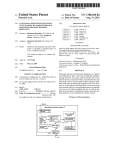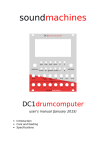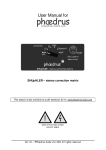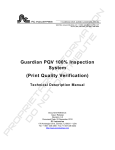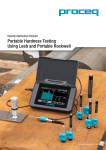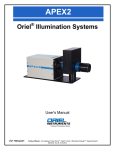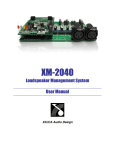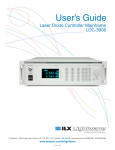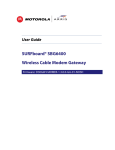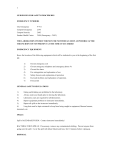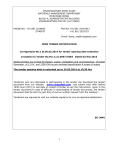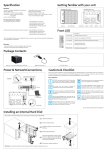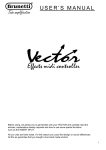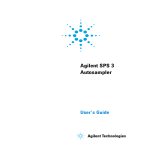Download Orfeusz206 User Manual v1.2 - WAF
Transcript
ORFEUSZ206 Advanced Speaker Management System for Surround Sound and Effects User Manual Software version 1.2 July 2007 Important Safety Instructions When you install Orfeusz in your equipment rack, make sure maximum operating temperature is observed. In particular, avoid placing it directly above heat producing equipment such as power amplifiers. To prevent shock or fire hazard, do not expose the unit to rain or moisture. For safety reasons, this unit is earthed-grounded. When connecting it to a power outlet, make sure a ground terminal is available. Always replace blown fuse with same type fuse and rating. Unpacking and Inspection Thoroughly inspect the packing materials and report any damage to the carrier at once. Report equipment malfunction to your dealer. In the box you should find the following items: Orfeusz206 hardware unit, power chord, USB cable, the user manual as well as a CD-ROM with the software and manuals in various languages. Inspect the contents and report any missing item. After unpacking the unit, save all packing materials in case you ever need to ship the unit. Cleaning Instructions To clean the hardware unit, simply wipe it with a soft cloth. You might use a mild soap and water solution to help loosen stains and dirt. Do not use any other detergents! Technical Support We at Wrocław Audio Force really want you to make the best of your Orfeusz. We welcome your questions on the phone or by email ([email protected]). An engineer will do his best to provide accurate answers and solutions to your possible problem. If your unit needs to be serviced, contact your dealer or our support service before shipping it back (see warranty below). We also welcome your suggestions. Is there a feature that could be improved? Is there a feature that should be introduced? Please let us know; we will consider the change and get back in touch with you. Warranty This product is covered by a warranty of 1 year from the date of original purchase, or accordingly to your local regulations. Warranty is granted to the original purchaser as well as subsequent owners during the warranty period. If you suspect your unit to malfunction although you followed the instructions contained in the user manual, contact the dealer where you purchased your product or our support service ([email protected]). Please be aware that this warranty does not cover damage occurring during shipment of this product. Claims for shipping damages must be made with the carrier. Wrocław Audio Force ul. Kotlarska 40 50-120 Wrocław (Poland) Tel +48 (0)71 343 99 44 www.waf.com.pl ____________________________________________________________________________________ 1 Wrocław Audio Force ORFEUSZ206 user manual Table of Contents Important Safety Instructions, Unpacking and Inspection, Cleaning Instructions, Technical Support, Warranty …………………………………………………………….… 1 Section 1: Getting Started ………………………………………………………………. General Overview Hardware Presentation Software Conventions 3 3 3 6 Section 2: Device Installation and Software Removal Software Installation Hardware Installation Software Removal ………………………………. 7 7 9 10 Section 3: Spatial Mode ………………………………………………………………. General Remarks about Loudspeaker Positioning Orfeusz206 Loudspeaker Positioning Tool Orfeusz206 Loudspeaker Calibration Tool Sound Field Models Software Environment 12 13 13 16 17 19 Master Virtual Sound Field Equalizer Effects Spatial Effects Automove Trajectory Editor Trajectory Playlist Manager Monitor 19 19 20 21 21 24 27 28 29 Joystick Configuration MIDI Control and MTC synchronization 30 32 Section 4: Stereo Mode ………………………………………………………………. Input Mixer Output Mixer System Configuration Example 1: Three-way stereo Linkwitz-Riley 12dB/oct Example 2: Two-way stereo with subwoofers Example 3: Double stereo with subwoofers 34 34 36 36 39 41 44 Section 5: Preferences, System Update and Stand-Alone Modes Preferences System update Stand-Alone Modes ………………. 46 46 47 47 Specifications ……………………………………………………………………..………… Appendix: List of MIDI controllable parameters …………..……………..…………….. 48 49 ____________________________________________________________________________________ 2 Wrocław Audio Force ORFEUSZ206 user manual Section 1: Getting Started Thank you for choosing the WAF Orfeusz206 Advanced Speaker Management System. Orfeusz206 was carefully designed, manufactured and tested, and we hope that you will be using it for long years with total satisfaction. Orfeusz206 is a spatial sound processing unit, delivered with its companion software running on a standard PC equipped with a Windows™ operating system. Orfeusz206 will introduce spatial sound attributes in your show, and allow you to perform real-time surround mixing. Additionally, Orfeusz206 will be helpful in conventional stereo setups. As this kind of device is not common on the market, we recommend that you read thoroughly the user manual to make the best of your new equipment. This first section deals with general aspects of the device, including hardware features and some software conventions. General Overview Orfeusz206 can work either in Spatial Mode, or in Stereo Mode, online (host-connected) or stand-alone. In Spatial Mode, Orfeusz emulates a user-defined acoustic model based on room properties and sound objects1 positions. In Stereo Mode, Orfeusz206 can route, shape and distribute in various ways the stereo input to outputs for a stereo sound setup. Spatial and Stereo modes are mutually exclusive: you run either a spatial sound setup, or a stereo one, and it is your responsibility to operate Orfeusz206 in the appropriate mode. To access the audio processing parameters, you need to launch a remote session (i.e. you need to connect the hardware unit to a free USB port of your PC and run Orfeusz206 control application). In remote session, all parameters can be altered, and changes take effect immediately. You need also to be in remote session in order to store or delete stand-alone modes. When running stand-alone, the external unit does not try to initiate a connection with the computer, and instead, processes audio according to parameters stored in memory. Stand-alone modes are appropriate for static spatial scenery or stereo configuration, and Orfeusz206 provides memory space for 3 independent sets of parameters. Selection of the operating mode is made with the front panel pushbutton. Hardware Presentation 1 5 1 6 Front Panel 2 3 4 Rear Panel 7 8 9 An object in this context is either one of the sources or the 'listener' – see section 3. ____________________________________________________________________________________ 3 Wrocław Audio Force ORFEUSZ206 user manual 1 2 3 4 5 6 7 8 9 OVD led: lights on when signals are clipping during processing Mode pushbutton: press to select operating mode Mode leds: indicate in which mode device is running Power rocker Serial number label Power connector with fuse drawer USB type B connector to host PC Balanced output jacks ¼" Balanced input jacks ¼" Audio inputs (9) and outputs (8) are symmetrical balanced, which means that you can feed here either symmetrical or asymmetrical signals. Just make sure that your cables conform to the most widely spread standard illustrated below. In particular, in no case should the ring terminal on a stereo jack be left unconnected. A safe rule is to always use stereo jacks for symmetrical signals, and mono jacks for asymmetrical signals. Symmetrical jack T (tip): Positive phase (hot) R (ring): Negative phase (cold) S (sleeve): Ground Asymmetrical jack T (tip): Signal S (sleeve): Ground Signals to inputs and from outputs are at line level. Never attach audio power amplifier outputs directly to any of the unit's connectors. If you wish to plug a microphone or an instrument to Orfeusz, you will need to intercalate a preamplifier. Orfeusz206 is equipped with a universal power supply and will work with any AC mains voltage between 100V and 240V. If you travel abroad, you don't need to care about anything except having an appropriate power chord at destination. Keep in mind that, for safety reasons, Orfeusz must be earthgrounded. If the fuse blows, replace it with a same type and rating fuse. See below the table for fuse specifications. Remove the power chord from the unit, and lift out the drawer (6) to access the fuse. If the fuse blows frequently, this might be a sign of malfunction. Contact your dealer or our support service. Fuse Type T 630 mA (slow type) Location Power receptacle on rear panel When you switch the hardware on, some leds are blinking in order to let you know that the device is waiting for your input. Indeed, you can choose either to start a host-remote session or a stand-alone mode if previously stored. The table on next page provides details of the leds' and pushbutton's (2) behaviour at start-up. While the unit is running, you can anytime switch to another mode (either to a stored stand-alone mode, or begin a remote session) pressing accordingly the pushbutton. Be aware that outputs will be muted when you press the pushbutton, until the device starts again in the selected mode. ____________________________________________________________________________________ 4 Wrocław Audio Force ORFEUSZ206 user manual If no stand-alone mode is stored, and the device is not connected, the red OVD led (1) is blinking. When this occurs, the only thing you can do is connect Orfesuz206 to a host computer and start a remote session (see next case below). Stand-alone modes can be stored or deleted within the control application while the unit is running a remote session. If no stand-alone mode is stored, and Orfeusz is connected to a powered computer, the green led HOST (3) is blinking to inform you that the device is ready for a remote session. To start a remote session, you need to launch Orfeusz companion application and select the Connect item from the File submenu. As soon as you start the remote session, HOST led will light on and stop blinking. If modes #2 and #3 for example were stored, and the device is physically connected to a powered computer, green led HOST, and orange leds MODE #2 and MODE #3 (3) are blinking. At this point you can either start a remote session, or select one of the two available stand-alone modes by pressing the pushbutton (2). If you press the pushbutton once, led MODE #2 will light on and stop blinking, meanwhile leds HOST and MODE #3 will keep on blinking 3 times. When these leds stop blinking, settings corresponding to stand-alone mode #2 are recalled from memory, and the device starts operating in this mode. While the latter leds are still blinking, you can press the pushbutton again to select stand-alone mode #3. #1 host #2 ovd #3 #1 host #2 ovd #3 #1 host #2 ovd #3 #1 host #2 ovd #3 #1 host #2 ovd #3 If you press the pushbutton once again, you will get back to the original situation, where Orfeusz awaits that you either connect for a remote session, or select a stand-alone mode among the ones available. #1 host #2 ovd #3 If the device is not physically connected, or if it is connected but the PC is not powered, and (for example) stand-alone modes #1 and #2 are available, orange leds MODE #1 and MODE #2 are blinking. Press once to select mode #1, or twice to select mode #2. After a short while, the led of the selected mode will light on without blinking, and the other led will turn off. At this moment, the device starts operating in the selected mode. #1 host #2 ovd #3 ____________________________________________________________________________________ 5 Wrocław Audio Force ORFEUSZ206 user manual Software Conventions As already mentioned, Orfeusz will either run a Spatial Mode or a Stereo Mode. When you start Orfeusz control application for a remote session, the first thing you should do – and before connecting – is select between these two modes. If the software is set in Spatial Mode, access the Stereo Mode in the File submenu. Conversely, if Orfeusz control application is set in Stereo Mode, click the Spatial Mode item in the File submenu for the device to operate in Spatial Mode. Orfeusz control application will start in the same mode that was run in the preceding remote session. In order to let you organize your screen space in the way you find it most practical, we provided a custom type of window, which can be arranged in various ways. As an example, we describe here the Equalizer window, as available in Spatial Mode. The pictures below show how the Equalizer window can be displayed. Available controls in the title bar allow you to show or hide window's features in order to save space on screen. The window can also be fully closed if not needed, clicking the (X) control. Window appearance has no effect on sound processing. For your convenience, screen general layouts may be further saved and recalled, like any preset (Window → Custom → Presets in the main menu). Thus you can organize, store and recall custom application layouts anytime. ____________________________________________________________________________________ 6 Wrocław Audio Force ORFEUSZ206 user manual Section 2: Device Installation and Software Removal This section describes how to install/uninstall the software onto/from your computer, and what to do when you connect the hardware for the first time. Depending on your Windows™ operating system version and configuration, the procedure described below, as well as the dialogue boxes shown, might slightly differ. If you are used to install applications on your computer, the following instructions will appear quite like a routine. If you are not, it might be a good idea to get some help from a reliable computer 'freak', or from your dealer. Software Installation 1. Before you begin, make sure the unit is not powered or not connected to the computer. 2. Start installing the software, either from the CD-ROM supplied with the unit, or after you downloaded the newest release from our website (http://www.waf.com.pl). A window similar to the one below will appear. Click 'Next'. 3. The next window will prompt you where files should be copied. By default, a new directory named Orfeusz206 will be created in Program Files directory. Click 'Next' to validate. 4. The following window will prompt you what name to give to the item that will appear in the Start Menu after installation. Default name is Orfeusz 206. Click 'Install'. ____________________________________________________________________________________ 7 Wrocław Audio Force ORFEUSZ206 user manual 5. Depending on your operating system version and configuration, the following warning dialogue box might popup. Click 'Continue Anyway'. 6. Files are now being extracted and copied. When this step completes, click 'Next'. 7. Click 'Finish' in the next window. That's it, you're ready now to let your system recognize your new hardware. See the following paragraph. ____________________________________________________________________________________ 8 Wrocław Audio Force ORFEUSZ206 user manual Hardware Installation When software installation completes, you can let Windows™ detect the hardware unit. This step is to be performed once only, when you connect Orfeusz206 to your computer for the first time. 1. Connect the hardware unit to a free USB port of your computer, and switch the unit on. Depending on your operating system version, a window might ask you to look for drivers online. Make sure you checked 'No, not this time' and click 'Next'. 2. Check 'Install the software automatically (Recommended)' on the following window, and click 'Next'. ____________________________________________________________________________________ 9 Wrocław Audio Force ORFEUSZ206 user manual 3. Again, depending on your operating system version and configuration, the following warning window might come on screen. Click 'Continue Anyway'. 4. After a short delay, you should see the last window informing you that the hardware is installed and ready to use. Click 'Finish'. Congratulations! You're ready now to use your new audio system. Software Removal If for any reason you wish to remove Orfeusz206 control application from your computer, a shortcut to the uninstaller is available in the Start Menu. 1. Make sure Orfeusz206 application is not running, turn the external unit off, and click 'Uninstall'. ____________________________________________________________________________________ 10 Wrocław Audio Force ORFEUSZ206 user manual 2. The next window will list items removed from your computer. When this step completes, click 'Close'. You can reinstall Orfeusz application anytime. ____________________________________________________________________________________ 11 Wrocław Audio Force ORFEUSZ206 user manual Section 3: Spatial Mode Orfeusz206 is the perfect system to add space dimension to your live show. It not only enables you to position the sources around the audience, but also lets you at will have sources come near and move away. Beside smooth movement capability, Orfeusz206 features additional tools to support you in making of your spatial session a delightful and successful practice. Because real-time spatial sound is quite uncommon in live setups, we recommend again that you carefully read this chapter, which encompasses instructions for positioning and calibrating loudspeakers, description of the various sound field models available, the software environment, as well as automation, effect coupling, joystick configuration and MIDI setup. The figure below shows a possible setting for a spatial session over 6 loudspeakers, where source are fed from a mixer and joystick and/or MIDI controlled. Audience is sitting or standing inside the perimeter defined by loudspeakers. Audience is here! ORFEUSZ206 USB chord Mixer PC running Orfeusz206 control application MIDI Controller Joysticks ____________________________________________________________________________________ 12 Wrocław Audio Force ORFEUSZ206 user manual General Remarks about Loudspeaker positioning Prior to positioning loudspeakers, there are several issues you should consider: How many loudspeakers do you plan to use? In what kind of site are you going to set your equipment for the show? Is it open-air? Or is it in a hall with strong natural reverberation? Can you freely position the loudspeakers? How large is the audience? Where is the audience going to sit or stand? Is audience supposed to look in a determined direction? (Is there a screen? a stage?) Proper assessment of the constraints bearing upon your show is a determining factor for a successful setup. Number of loudspeakers For the smoothest source travel in space, we recommend that you use 6 loudspeakers, preferably all identical. Indeed, with 6 loudspeakers properly positioned, you will be able to place and displace smoothly your sources wherever in the plan and around the audience. If moreover all loudspeakers are identical (and properly calibrated – see next paragraph), Orfeusz206 will generate a sound field homogeneous in all directions. However, there might be reasons why you don't want to use 6 loudspeakers. An obvious reason might be that you don't have so many of them available for your setup. Another could be that, for your personal aesthetics or some other technical imperative, you decided a priori that you would use only 4 of 5 of them. What you need to keep in mind: A number of 4 loudspeakers at least are required for a spatial mixing session with Orfeusz206. The more loudspeakers, the better your control on sound localization and source movement. Preferably all loudspeakers are identical. Performance site It is worth that you study in detail the performance site before you position your loudspeakers. Have a walk through it and localize exits, possible bars and obstacles, all these places were you definitely would not be allowed to put a loudspeaker. Have a tape measure ready and make a dimensioned sketch of the site. On the same sketch, mark obstacles, stage, audience area and the mixing spot. If the performance is to be open-air, then you're likely to manage a perfect setup. Otherwise, Orfeusz206 will assist you to achieve the best speaker configuration meeting room constraints. What you have to remember: The ideal configuration is attained with loudspeakers placed on a circular perimeter, with same angle between successive loudspeakers. If this configuration is not feasible, Orfeusz206 will correct loudspeaker emissions in order to achieve a homogeneous sound field – but keep as close as possible to the ideal circular setup. Spatial field is inside the perimeter delimited by loudspeakers. The larger this area, the more people you can fit in for the show – but don't make this area unnecessarily large. Whenever possible, place loudspeakers at appropriate listening height i.e. head level. In most cases, there is no obvious setup. Take your time to consider various speaker configurations to appreciate and build a satisfactory system setup. Orfeusz206 Loudspeaker Positioning Tool This step should be completed each time you take on a new installation. To access the loudspeaker positioning tool, select Settings → Loudspeaker Setup… in the main menu. ____________________________________________________________________________________ 13 Wrocław Audio Force ORFEUSZ206 user manual The Setup Type panel shows three possible options: Custom. This is our preferred method for positioning loudspeakers, based on an ideal circular setup that you gradually alter to meet your requirements. ITU 5.1. This one is for a conventional 5.1 setup, which is suitable if you intend to mix on top of prerecorded 5.1 materials. Fixed. This method has to be selected if speaker configuration is fixed and imposed. Do not use this option in any other context, as Custom option will generally produce better results. The first time you display Loudspeaker Setup window, it shows one Custom example – which is actually Wrocław Audio Force developers' room (preset waf office 6spk). The red region is the room area, and obstacles are represented in black: these are the places where we don't want to put any loudspeaker. The yellow circle is the ideal loudspeaker perimeter, and the arrow in the middle shows the 'North': that's the reference direction (we'll talk about it further again). This setup is based on 6 loudspeakers symbolized by green circles where numbers are referring to outputs. Performing the Loudspeaker Setup procedure consists in completing a similar layout, of course adapted to your situation. Zoom Position at cursor ____________________________________________________________________________________ 14 Wrocław Audio Force ORFEUSZ206 user manual To build your own Custom setup: Press New and select Custom in Setup Type panel. In the black area, draw lines representing the walls of your place. We recommend that you measure all relevant distances from a common point in the room. Furthermore, assigning to this point the couple of coordinates (0, 0) should ease the procedure. To draw the room area, click to mark each vertical edge, and finally double-click to complete (the first and last point will be automatically connected together). Loudspeakers will pop up on screen, but ignore them at this stage. Draw obstacles the same way you drew the room. Obstacles are all these areas where you cannot or don't want to put a loudspeaker. By right-clicking access undo and delete commands. Now, drag the yellow arrow to the center of the audience. Speakers are bound to sweet spot and will move accordingly. Rotate sweet spot in the desired direction (figure). This is the 'North', i.e. the reference direction of sound sources. If you right-click on a loudspeaker, you access a contextual menu with special commands. By selecting Withdraw, you remove a loudspeaker from the spatial setup – this means that Orfeusz206 output with same number will not participate to the spatial field. Right-clicking on the same loudspeaker and selecting Bind allows you to use this output again. Swap commands allow swapping two loudspeakers. It's at this stage that you define how many loudspeakers you intend to use. Position the mouse cursor on the yellow circle, click and drag to dimension the loudspeaker perimeter, and to orient globally loudspeakers (figure). Finally, drag each loudspeaker individually to the most convenient location. Each loudspeaker may be displaced in a perimeter defined by the thin yellow lines. Size of this perimeter depends on the number of loudspeaker used for the setup: the more of them, the larger the area. When you are finished, consider saving your layout. To build a ITU 5.1 or Fixed setup: Drawing the performance hall is not required for these setup types, because by definition they don't offer any placement freedom. Indeed, ITU 5.1 setup has standardized loudspeaker placement, meanwhile Fixed setup type should be used only in a hall where loudspeakers are fixed and can't be moved at all. In the Setup Type panel, select the desired setup type. Loudspeakers pop on screen immediately. For your convenience, you may draw the room shape, as well as landmarks for reference. For ITU 5.1 setups, drag sweet spot to the desired location, then rotate and resize loudspeaker perimeter. Central speaker always designates the 'North'. For Fixed setups, drag loudspeakers to the appropriate position, or edit their locations in the Loudspeakers panel. Loudspeaker placement should always enclose audience. Drag the sweet spot to the appropriate position (or let Orfeusz control application find the best one for you, by checking the Auto box), and rotate as desired. Subwoofers If your spatial setup is based on less than 6 loudspeakers, you may use the remaining outputs to feed subwoofers. Unused outputs carry the monophonic sum of all spatial signals, low pass filtered according to your settings in the Subwoofers panel. When subwoofer functionality is switched on, lower frequencies fed to subwoofers are filtered out from spatial signals. ____________________________________________________________________________________ 15 Wrocław Audio Force ORFEUSZ206 user manual Orfeusz206 Loudspeaker Calibration Tool Orfeusz206 comes with a calibration tool reachable from the main menu: Settings → Loudspeaker Calibration. The aim of calibration procedure is to align output levels of every loudspeaker in the setup to make sure that the sound field is homogeneous, and that there's no preferred direction. Orfeusz206 calibration tool will command the external unit to output pink noise. We like pink noise for calibration purpose, because most musical programs have similar average power spectrum density. Loudspeaker Calibration window displays your speaker setup in a simplified fashion. The yellow arrow in the middle shows the same 'North' direction. To start calibration process, click Start button. Orfeusz206 mutes now all outputs. Click Next. Orfeusz206 emits pink noise on the first output used for spatial speaker setup (outputs dedicated to subwoofer feed are not taken into account in the calibration process). If you wish to start a calibration from scratch, click Reset to set all loudspeakers level to minimum. Adjust level with the slider so that you get a similar level to what you expect during performance. Place a sound level meter at sweet spot position (or ask someone with reliable ears to stand at sweet spot) and register the sound level. Click Next. Orfeusz206 emits now pink noise through the next output in clockwise order. Adjust level on slider so that you get the same sound level as registered previously. Loudspeaker Calibration window highlights in red the speaker that is emitting, so this is a good opportunity to check also your loudspeaker wiring. Repeat until you adjusted the level for all loudspeakers. When you're finished, click Close: you're ready to mix now! Note: Pink noise is generated at –12 dBFS level. Hence, maximum output level at calibration stage (when sliders are in utmost position) is –6 dBu. ____________________________________________________________________________________ 16 Wrocław Audio Force ORFEUSZ206 user manual Sound Field Models In order to cover all your possible needs, 4 different sound field models were made available (see Virtual Sound Field window for how to switch between these models). In Panning Only mode, the only spatial cue to be rendered is the source azimuth, through appropriate panning. Sources are displayed on circles centered on the listener. In this mode, you can freely rotate the listener, or both sources individually, or eventually both sources together thanks to the cross (X) control linking both sources. Be aware that in this simplest mode Automove and Spatial Effects are not available. Panning Only mode doesn't entail any sound coloration. To move sources, drag them individually with the mouse to the desired location, or displace them together dragging the cross (X) symbol. To rotate the listener, place mouse cursor on the green spot to have the following symbol displayed, and rotate in the appropriate direction. Note that listener is facing 'North' when positioned upwards, as depicted in the screenshot below. Trick: to lock the angle between the two sources while moving them collectively, double-click on the cross (X) symbol. listener source linking control sources Free Field model emulates sound propagation of sources in a free field. This mode renders all spatial attributes – azimuth, distance and speed – in a virtual anechoic environment. A circle of adjustable size surrounds the listener and shows the reference distance. At reference distance, source loudness is maximal, and will not increase if source is moved closer to listener. This is to avoid clipping signals, but should also be used to tailor the depth of the acoustic environment. To increase or decrease reference ____________________________________________________________________________________ 17 Wrocław Audio Force ORFEUSZ206 user manual distance, place mouse cursor to have the following symbol displayed, then click and drag to adjust. In Free Field mode, objects may be displaced with mouse, or preferably with joysticks (see joystick section). Except when sources or listener are moving (because of Doppler effect), Free Field mode doesn't entail sound coloration neither. Motion Optimized and Space Optimized modes are the most complete simulations, including all spatial sound attributes in a user-defined acoustic. In these modes, you set the kind of acoustic atmosphere that suits your show, by defining the room dimensions as well as wall materials. Along with direct sound, wall reflections are computed, updated and rendered in real-time. Although these are the most powerful modes in the set, you should remember that sound coloration and artifacts might occur as for natural sound propagation. Typically, when you position a sound source against a reflecting wall, the sound heard by the listener is mainly the combination of direct sound and one reflection slightly delayed – which is a comb filter. Sound coloration occurs in our model because it occurs in real world too. Motion Optimized mode is especially suitable if sources are moving a lot and quickly. Space Optimized, although quite similar, is more focused on acoustic rendering (room acoustic is more detailed), and might produce slight sound distortion when sources are moving in very reverberant virtual environments. Experiment and pick the mode that suits better your artistic goal. Use the reference distance circle to proportion sound objects and balance early reflections and late reverberation. sources listener – and reference distance circle virtual room walls ____________________________________________________________________________________ 18 Wrocław Audio Force ORFEUSZ206 user manual Software Environment Master Master allows you to monitor input signal level and adjust output level. General and individual soft mute switches are available for inputs as well as for outputs. Output level sliders should remain linked after speaker calibration completion. Input level is displayed in dBFS (dB Full Scale). Always keep sufficient headroom in order not to clip. The required headroom for EQ and effects depends of course on your settings. input level meters mute all inputs mute all outputs output level sliders Link switch individual Mute switch Virtual Sound Field Virtual Sound Field window allows selecting between the 4 sound field models described earlier. If Panning Only or Free Field models are selected, the remaining of the window is disabled. With Motion Optimized and Space Optimized models, which are the true spatial modes, you can further define the virtual listening environment by specifying virtual room dimensions and wall materials. The figure in the middle shows the resulting room impulse response (with predefined listener and source positions). After you made a change to virtual room definition, click Apply button for taking changes into account. The latter impulse response is complemented with late reverberation, whose parameters are automatically set for a realistic global acoustic atmosphere. You can modify these parameters if you deselect Autoset option, and selecting Autoset again will reset parameters to their software-computed values. Modulation option should be normally off, unless some particular noise-like sound such as cymbals produces objectionable late reverberation. Switching on this option corrects in most cases any possible metallic sounding, at the expense however of a small amount of vibrato which might be objectionable on acoustic instruments (piano). ____________________________________________________________________________________ 19 Wrocław Audio Force ORFEUSZ206 user manual Predelay is a classic parameter for reverberation systems, and refers to the amount of time delay (in ms) between direct sound and the beginning of late reverb. Colour refers to low pass filtering, simulating air and wall absorption of high frequencies. Volume is the general level of reverberation. At last, in Free Field, Motion Optimized and Space Optimized modes, there's an option called Boom, which modifies direct sound panning law when sources come close to the listener (i.e. when sources come inside the reference circle around the listener). This option is especially recommended when sources are 'going across' the audience, and limits the 'hole' caused by signals tipping from one side to the other of audience, by progressively feeding all loudspeakers. Boom option is without effect when sources are out of the reference cercle. Equalizer Orfeusz206 includes a parametric equalizer on both input channels. Clipping led On/Off switch (bypass) High frequencies shelving filter Mid-frequencies peaking filters Low frequencies shelving filter The selected EQ filters implementation is not likely to clip strongly. Bypass switches are clickless. Equalizer can be turned on and off anytime during performance. Corresponding equalizing curves are displayed on the right hand side. Double-click on a graph to toggle between –12/+12 dB and –24/+24 dB scales. Lower peaking filter parameters might be mapped to trajectories (see Spatial Effects). ____________________________________________________________________________________ 20 Wrocław Audio Force ORFEUSZ206 user manual Effects Additionally to an EQ section, each input channel includes an effect section comprising flanger, vibrato and chorus. Only one effect per channel can be turned on at a time. Click here to link effects on both channels When effects are stereo linked, settings from channel 1 are transferred to channel 2, and oscillators run in phase or in quadrature, depending on which effect is running. Bypass switches are clickless: you can turn effects on and off anytime. Use the Level knob to align output levels when effects are on and off. Each effect is equipped with a clipping led. For negative Feedback, an option called Strong Flange is available for flanger. When this option is selected, the flanger will produce an intense effect sound. Effects can be mapped to trajectories (see Spatial Effects). Spatial Effects Spatial Effects are not effects by themselves, but rather a new way of coupling effect parameters to source trajectories. Indeed, when Spatial Effects are turned on, traditional effect parameters are continually updated while sources are moving, according to laws that you accurately tuned. Spatial Effects may be applied to both channels, one effect at a time, and to following parameters as summarized in the table below. EQ Central frequency Gain Quality factor Flanger Rate Delay Mix Vibrato Rate Delay Mix Chorus Rate Depth Mix These latter parameters can be coupled to source azimuth, distance or speed, always relative to listener. ____________________________________________________________________________________ 21 Wrocław Audio Force ORFEUSZ206 user manual As this kind of effect coupling rather unusual, we are going to have a close look now at two examples, the first one being a 'Spatial EQ', and the second a 'Spatial Vibrato'. Example 1: Spatial EQ A Spatial EQ is actually the lower second-order peaking filter in Equalizer window, whose gain, quality factor and frequency parameters are adjusted according to source movement. In the present example, we wish to couple 1. filter central frequency to source azimuth, 2. gain to distance, and 3. quality factor Q to speed. Note that this is just an example, and we could couple parameters in a completely different fashion, or couple only one or two of them and leave the remaining constant (a spatial effect with all coupling knobs set to Off is identical to a traditional effect – all parameters are constant). There are 2 Spatial Effects windows, one for each channel. In order to set a spatial EQ on channel 1, you first need to select EQ in Spatial Effects – Channel 1 window, as illustrated below. In this current example, we couple EQ peaking frequency to source 1 azimuth relative to listener. This means that EQ peaking frequency will be automatically adjusted when source 1 turns about the listener. To achieve this, position Coupling knob on Azimuth, as illustrated. With the Range control, set the bounds for frequency sweeping. When the source moves about the listener, the filter central frequency will sweep the Range interval, between these two limits. Use the second control to adjust for what azimuth should the maximum frequency value occur. The minimum frequency will occur at the diametrically opposite direction. Eventually, there's yet another switch allowing you to select between linear (Lin) or logarithmic (Log) sweeps. The figure on next page compares how the parameter will change for both laws. Logarithmic law is especially suitable for frequency sweeps – it generates a constant speed sweep on the logarithmic frequency scale of EQ graph. ____________________________________________________________________________________ 22 Wrocław Audio Force ORFEUSZ206 user manual Range maximum value LINEAR LOGARITHMIC Range minimum value In order to couple gain to distance, set the knob of gain section in the appropriate position. With the Range control, select the lower and upper limits of the gain interval. Select with the Distance control values of distance for which minimum and maximum gains should occur. Finally, with the Direction switch, select whether gain should increase (Asc ascending law) or decrease (Desc descending) as distance grows. Note that the maximal distance in the Distance control is the virtual room diagonal. The resulting gain variation is depicted in the graph below. gain max gain ascending descending min gain distance to listener lower distance upper distance Eventually, we are now going to couple quality factor Q to source speed. This last step is quite similar to distance coupling: position Q Coupling knob to Speed, and select your appropriate ranges. A still source has speed 0. Example 2: Spatial Vibrato In this current example, we are going to show that various effect parameters may be coupled to the same trajectory attribute. Indeed, we wish here to couple both Rate and Mix vibrato parameters to source to listener distance. In order to achieve that, you need to switch on Vibrato in Spatial Effects, and turn rotating Coupling knobs accordingly – see the screenshot on next page. Parameter Delay is left constant (i.e. is not coupled). To complete the settings, adjust Ranges and Distance upper and lower limits as desired. ____________________________________________________________________________________ 23 Wrocław Audio Force ORFEUSZ206 user manual Automove Orfeusz can also generate automated trajectories of various types. You can store up to 5 trajectories per object2 and trigger any of these anytime (additionally to an unlimited number of presets). Automated trajectory n° 3 currently used for source 1 Lobes number (cardioids only) Trajectory type selector Motion direction switch Listener spinning speed and direction control Motion speed adjustment knob Start/stop motion To trigger automated trajectory n°3 for source 1, click the corresponding button n°3, and trajectory is immediately launched. For editing trajectory parameters, just access the corresponding controls: with the Speed knob, you can accelerate or slow down motion, and with Direction switch, you can reverse motion direction. Listener can additionally spin at the rate and in the direction desired. If you wish to reshape source trajectory, we recommend that you first stop movement ( ). Four kinds of trajectories are 2 An object in this context is either one of the sources or the listener. ____________________________________________________________________________________ 24 Wrocław Audio Force ORFEUSZ206 user manual available, and detailed on next page. Note that the right-most knob, enabled only when you select a cardioid trajectory, allows you to select the number of lobes. When you're finished editing, consider saving as a preset or storing in the memory slot designated by the trajectory switch. Press to launch motion again. Drag this square (or any other) to resize or reshape the trajectory (cursor: ). Drag this round to rotate the whole trajectory about listener (cursor: ). Position mouse cursor on object (cursor: ). Click and drag to redraw trajectory from scratch. Drag this square to displace the whole trajectory (cursor: ) ____________________________________________________________________________________ 25 Wrocław Audio Force ORFEUSZ206 user manual Elliptic or circular trajectories. Constant angular speed motion. When ellipse is very flat, source seems to travel back and forth on a line segment. Planetary motion. Same as above, except that angular speed is not constant, but obeys a law similar to celestial body motion. The point inside the curve is the ellipse's focus. Spiral. Constant angular velocity. Drag the small round to adjust the number of turnings from center to periphery. Cardioids. Constant angular velocity. Various shapes are achievable according to settings. Adjust the number of lobes with the right-most rotating knob. Adjust lobes shape by dragging the small round. ____________________________________________________________________________________ 26 Wrocław Audio Force ORFEUSZ206 user manual Trajectory Editor Trajectory Editor is a flexible tool allowing recording and editing of trajectories as well as associated spatial effects. In the context of this editor, a trajectory is more than just movements and comprises: Both sources' and listener's movements, The Virtual Sound Field mode and settings, Listener's reference distance adjustments, And eventually effects and spatial effects. Prerecorded trajectories are saved as compact binary files with OTF extension (Orfeusz Trajectory File format), and may be played back in a given order (see Trajectory Playlist Manager). Time cursor Recording source select Time at cursor position 1 2 3 4 5 6 7 8 9 10 11 12 Total length Portion of file currently on display Position of cursor within file Slider Total file length 1 2 3 4 5 6 7 8 9 10 11 12 Playback synchronization with an incoming MIDI timecode (MTC) Play Record Stop Locate cursor at beginning of file Fast rewind (5x) Fast forward (5x) Locate cursor at end of file Start new trajectory Load trajectory Save trajectory Queue trajectory in Playlist Manager ____________________________________________________________________________________ 27 Wrocław Audio Force ORFEUSZ206 user manual In order to record a new trajectory from scratch: 1. Press New. 2. Select the Virtual Sound Field mode and adjust settings. 3. Select the source of your recording. This can be any combination of Source 1, Source 2, Listener and Effects. 4. Press REC key. Trajectory Editor's window shows events occurring for each object. Effects changes are displayed as vertical markers, meanwhile object displacements are displayed as hatched areas. To perform a zoom in or out, resize the slider. Simply click on the graph to place the cursor at the desired location. While recording movements, objects may be animated by all available means: mouse dragging, joystick activation, MIDI commands or even Automove. Movements can be recorded in a sequenced fashion. Indeed, you might want to record first Source 1 movement (select Source 1 and deselect all others in the recording source selection panel), then record Source 2 movement (deselect now Source 1 and select Source 2), and finally record Listener's movement. Once you are satisfied with the global trajectory, you can add effects (select Effects and deselect all others). Objects, which were not selected as recording source, are moving according to file's contents. A contextual menu (right-click) offers editing commands – among other things, you may suppress unwanted parts at the beginning (Clear before cursor command) or at the end of the file (Clear after cursor command). Be aware that, when playing back a prerecorded trajectory, objects will move according to what's recorded. Joysticks, mouse dragging and Automove are disabled, and settings in the Virtual Sound Field window are locked until the trajectory completes. Trajectory Playlist Manager Trajectory Playlist Manager, along with Trajectory Editor, enables to build any automated sequence of trajectories. A playlist is an ordered sequence of trajectories. Playlists are saved as files with OPF extension (Orfeusz Playlist File format). Playlist title (file name) List of trajectories Playlist total length Slider Transport section (Sync/Previous/Play/Stop/Next and Repeat) ____________________________________________________________________________________ 28 Wrocław Audio Force ORFEUSZ206 user manual We are going to show here a basic example using most of the controls. Our example is a sequence built on 4 different parts: an intro, a part A, a part B, and an ending. We wish to achieve the following structure: intro PartA PartA PartB PartA PartA PartA PartB PartA ending 1. Press New to start a new playlist. 2. Press Add in order to add to the empty playlist the 4 required parts. Multiple selection in the Open dialog is obtained by pressing the Shift or the Ctrl keyboard key. Then, by dragging files in the playlist manager, you can easily alter the sequence order and get the result illustrated in the screenshot on previous page. 3. Select file partA, right-click and select Duplicate from the contextual menu. Repeat this step once again, and order files to obtain the sequence exemplified on the screenshot opposite. 4. Select the 4 files forming the AABA pattern (press Ctrl or Shift key to select several files), and duplicate the whole pattern as above. If necessary, organize again the sequence playing order. 5. You might consider saving your playlist. Press Save and enter a suitable filename (here Example 1). 6. Hit the Play key in transport section to start playing the sequence. Keep in mind that direct control of objects is disabled when playing a prerecorded trajectory. The transport section includes 2 handy controls determining how the list should be played back, as described in the table below. 1 All 1 All Playback stops after each file. Press Play again to launch next file. All files are played back, then player stops. Selected file is repeated endlessly. Whole playlist is repeated endlessly. ____________________________________________________________________________________ 29 Wrocław Audio Force ORFEUSZ206 user manual Monitor Monitor window displays the amount of processing power currently in use. CPU designates the PC processor, and the graph bar shows the total amount of processing power, including Orfeusz206 control application and all other services in use. DSP designates the external unit digital signal processor load. Joystick configuration Joystick Options window is accessible from the main menu (Settings → Joystick Options…). Up to three joysticks can be connected to Orfeusz206 to control individually all three objects movement – but you can also use one single joystick and configure buttons to toggle control between objects. Joysticks may be of ancient D-connector type, or equipped with a USB connector. Although you may use mouse and even keyboard to control objects movement, we recommend the use of joystick for a smooth and realistic trajectory. Indeed, with mouse you may achieve accelerations not feasible in the real world, and hence produce unrealistic sound output (a public speaker traveling 20 meters in a fraction of second, with abrupt acceleration and stop, would not sound natural even in the real world…), meanwhile object control with joystick is based on a motion and friction forces model ensuring smooth trajectory. Select the Joystick tab corresponding to the peripheral you want to configure (this may be Joystick 1, Joystick 2 or Joystick 3). In the Device combo box, associate one of your peripherals to the joystick being configured. Assign an object to your peripheral in the Object combo box. By default, the joystick will control the designated object. Adjust joystick control over object's dynamics by setting Acceleration and Friction sliders. You can further assign functions to joystick buttons. In the Actions section, select which button you wish to configure in the left-hand combo box, and assign an action in the righthand one. The table on next page summarizes all the actions available for joystick buttons. When you are finished configuring all your joysticks, click OK to return to the main interface. Hint 1: When adjusting joystick settings, click Apply and test. Click OK to return to the main window, or change settings again until you are satisfied. Hint 2: You can assign multiple actions to a single button. For example, you might want that one button triggers a trajectory AND turns effect on. To achieve this, select twice the same button in the left-hand combo boxes, and assign actions in the right-hand ones. ____________________________________________________________________________________ 30 Wrocław Audio Force ORFEUSZ206 user manual Actions assignable to joystick buttons Change Object to Listener Change Object to Source 1 Change Object to Source 2 Toggle Source Control On/Off Automove 1 On/Off Automove 2 On/Off Automove 3 On/Off Automove 4 On/Off Automove 5 Start/Stop EQ Start/Stop Flanger Start/Stop Vibrato Start/Stop Chorus If you use less than 3 joysticks, you can configure buttons to switch control to another object. Trigger an automated trajectory. Switch effect (and corresponding Spatial Effect) on. The illustration below shows an example of joystick configuration. This is a regular joystick for gamers, equipped with 11 buttons (trigger is usually button 1). Actions were assigned to 'only' 8 buttons. This configuration allows toggling motion control between the 2 sources. Note that while controlling Source 1, buttons trigger automated trajectories for Source 1 and turn on effects on channel 1, and while controlling Source 2, buttons trigger actions on Source 2 and channel 2. Button 4: Change Object to Source 1 Button 6: On/Off EQ Button 7: On/Off Flanger Button 8: On/Off Automove 1 Button 5: Change Object to Source 2 Button 11: On/Off Vibrato Button 10: On/Off Chorus Button 9: On/Off Automove 2 ____________________________________________________________________________________ 31 Wrocław Audio Force ORFEUSZ206 user manual MIDI Control and MTC synchronization Orfeusz206 may be controlled and synchronized by MIDI messages. A MIDI configuration window is available in the main menu. The first tab allows selecting the MIDI port receiving messages. This can be either a physical port to which a device such as a MIDI controller is connected, or of course a virtual port as shown on the screenshot. Virtual ports are handy solutions to synchronize, by using MTC (Midi TimeCode), two applications running on the same computer. In the context of spatial audio, you will generally sync Orfeusz and an audio or video player. At the present time, Orfeusz does not emit any MIDI message. As a consequence, Orfeusz is always the 'slave' of a 'master' application or external hardware device. The second tab, named Sync, is dedicated to synchronization. The edit box on top allows inputting an offset. Underneath, the application shows the current incoming MTC time, as well as the timecode framerate. Pressing one of the MIDI buttons available on the Trajectory Editor window, or on the Playlist Manager Window, activates synchronization. Finally, the last tab enables to associate a MIDI controller to virtually any parameter of the application (see the full list of controllable parameters at the end of the manual). In order to control a given parameter: - Press Add, and select from the structured pop-up menu the desired parameter. - Select the corresponding MIDI channel (CH1 to CH16) and controller number (CC0 to CC127) thanks to the two combo boxes available on the right-hand side. Orfeusz is moreover able to learn by itself the data identifying the controller - this feature eases the MIDI configuration stage. ____________________________________________________________________________________ 32 Wrocław Audio Force ORFEUSZ206 user manual To enable that feature, press Learn button and activate the MIDI controller (knob, button, fader, MIDI sensor etc…) you wish to associate to the selected parameter. Orfeusz sets automatically the channel number (CH) and the controller number (CC). Sound objects may also be MIDI controlled. Fx parameter is related to left to right displacement, meanwhile Fy parameter is related to forward and backward motion. As with joysticks settings, one can adjust dynamic motion properties of the sounding objects, by setting the Acceleration slider. However, friction parameter is univocally set by the Friction slider in Joystick configuration window (see previous paragraph). ____________________________________________________________________________________ 33 Wrocław Audio Force ORFEUSZ206 user manual Section 4: Stereo Mode Although Orfeusz206 is a spatial sound unit, it also provides an alternate Stereo Mode useful for managing speakers in a conventional stereo set-up. Stereo Mode comprises 3 main modules: Input Mixer, Output Mixer and System Configurators. We call here system any combination of filters/eq/gains/delays required to perform a full crossover unit. This section describes successively the various modules, and then illustrates with general examples how Orfeusz206 crossover systems allow for extra-fast set-up. Input Mixer The block diagram of the Input Mixer is shown below, and consists of identical gains, delays and graphic equalizers available on each section. Inputs 1 and 2 are summed to provide signal 'mix', appropriate for feeding subwoofers. in 1 in 2 delay graphic EQ 1 delay graphic EQ mix delay graphic EQ 2 Here are operation details about the Input Mixer. Please refer to the screenshot on next page to locate corresponding controls. Level-meters show signal level in dBFS at A/D conversion stage. Inputs 1 and 2 are equipped with a soft-mute button. When adjusting gain, make sure not to clip signals. A clipping led is available in gain each section. Delay values can be either typed in the edit boxes, or set with the jog-dial, which has gross and fine adjustment knobs. To switch on graphic EQs, click the corresponding 'On' switch. Click again to switch off (bypass). Graphic EQs may be linked ('Link' button): the changes made to one section are duplicated in the two other sections. EQs' filters bandwidth is adjustable (narrow, medium or large). You can load and save EQ presets ('Preset' button). For a flat correcting curve, load the flat factory preset. EQ output level is adjustable from –12 dB to +12 dB. If the EQ section is clipping (red led), lower the input gain in that same section. To set an EQ slider back to 0, double-click on it. ____________________________________________________________________________________ 34 Wrocław Audio Force ORFEUSZ206 user manual The table below summarizes Input Mixer specifications: Max input level Gain Delay Graphic EQ Input Mixer Specifications +9 dBu (= 0 dBFS) adjustable -∞ to +12dB adjustable 0 to 300 ms 31 third-octave bands, –12dB/+12dB level meter input gain slider delay jog-dial with gross/fine adjustments input clipping led On/Off switch (bypass) Preset switch EQ clipping led show/hide EQs Link switch EQ output level Mute switch 31-band graphic EQ EQ bandwidth selector ____________________________________________________________________________________ 35 Wrocław Audio Force ORFEUSZ206 user manual Output Mixer Output Mixer comprises as many identical sections as there are systems. Systems are combinations of crossover filters and EQs driving broadband speakers, and may be one-way, two-way or three-way. They are discussed more in details in the next paragraph. The figure below shows how the Output Mixer window looks like in a stereo set-up with one subwoofer: there are 3 identical sections (left, right, and sub). Each section consists of a level control, a delay with jog-dial and a soft mute switch. Output level controls may be linked so that general level may be changed in one step, without altering the relative settings. delay jog-dial output level control output level link switch Mute switch Output Mixer Specifications Max output level +6 dBu (= 0 dBFS) Gain adjustable -∞ to 0 dB Delay adjustable 0 to 150 ms System Configuration Systems are available in 3 variations: one-way, two-way and three-way systems. The block diagrams below outline the components of each system type. One-way Two-way Three-way in in in ± param. EQ out ± delay param. EQ out lo ± delay param. EQ out hi ± delay param. EQ out lo ± delay param. EQ out mid ± delay param. EQ out hi ____________________________________________________________________________________ 36 Wrocław Audio Force ORFEUSZ206 user manual One-way systems have one input and one output. They provide independent low-pass and high-pass filters and, as a consequence, total control over crossover filtering. The EQ tab gives furthermore access to 4 fully parametric filters, which can be low-shelf, high-shelf or peaking, with adjustable frequency, gain (-12 dB/+12 dB) and slope/quality factor. polarity switch slope selector knob filter type switch (Buttorworth or Linkwitz-Riley) bypass switch clipping led system name edit box low corner frequency high corner frequency ____________________________________________________________________________________ 37 Wrocław Audio Force ORFEUSZ206 user manual Two-way and three-way systems have one input, and 2 or 3 outputs. They were made available in order to save time at set-up stage (see examples below). Setting up a crossover network with a multi-way system config window imposes the following constraints: Crossover filtering type (Butterworth, Linkwitz-Riley or FIR) is common to all filters within the system. Successive filters are overlapping at corner frequencies (-3 dB for Butterworth filters, -6 dB for Linkwitz-Riley and FIR filters). Polarities of the various outputs are automatically set when obvious, but can be modified further. Moreover, you can compensate for time misalignment in your system thanks to dedicated short delay lines (max 10 ms), as well as for drivers' efficiency discrepancies thanks to independent gain controls (from -6 dB to +6 dB). Finally, activating the LF Cut option allows associating a subwoofer to any multi-way system (except FIR). time alignment controls level alignment controls low frequencies cut switch low frequencies filter cutoff frequency jog-dial Additional hints: You can zoom in part of the frequency response graph. Just click and select with the mouse the region to be zoomed. To zoom out back to the original view, simply click on the graph. Each output has four dedicated parametric filters. There's a number of clipping leds equal to the number of ways. These leds warn of clipping both in the crossover filters and in the EQ section. Crossovers Parametric EQ 3 System Config Specifications Butterworth (6, 12, 18, 24, 48 dB/oct), Linkwitz-Riley (12, 24, 48 dB/oct), FIR3 (max. 511 coefficients) 4 filters per output, configurable as low-shelf, high-shelf or peaking filter. Gains –12dB / +12dB Not available for 1-way systems ____________________________________________________________________________________ 38 Wrocław Audio Force ORFEUSZ206 user manual Example 1: Three-way stereo Linkwitz-Riley 12dB/oct The following examples illustrate the ideal way to use systems in order to complete your set-up configuration in a very short time. Some of the commands given here were not studied before, so we recommend you to view these examples as exercises helpful to learn how to make the best of your Orfeusz206. This first example deals with a pair of 3-way cabinets with 100 Hz and 1000 Hz cutoff frequencies. Additionally, we wish to set a Linkwitz-Riley 12dB/oct crossover network on all 3 elements. 1. Click on the 'New' set-up icon to start from scratch. 2. Click on the 3-way system icon (or right-click on the layout window and select insert 3-way system from the contextual menu). A 3-way system is inserted in the layout window. 3-way system icon New setup icon 3-way crossover symbol ____________________________________________________________________________________ 39 Wrocław Audio Force ORFEUSZ206 user manual 3. Double-click on the 3-way crossover symbol (or View → Systems → three-way in the menu) in order to open the crossover settings window. 4. Switch off LF Cut if it was on. 5. Set the filtering switch to IIR. 6. Set the crossover network type switch to Linkwitz-Riley (L-R). 7. Turn the slope knob to the 12 dB/oct position. 8. Type into the edit boxes the desired cut-off frequencies (or use the dial wheel). 9. In the Name edit box, type in the name of your system. In this example we chose 'left'. You're finished with the basic settings for the first system. Note that polarity of the second driver was automatically reversed in order to align drivers' phases at cutoff frequencies (characteristic of 12dB/oct Linkwitz-Riley crossover networks). If necessary, you can adjust the Level of each element in order to compensate for loudspeakers efficiency. You can also adjust Time sliders to compensate for distance misalignment. The basic expected result is shown below. 10. Now we assume that your left and right systems are identical. Simply right-click on the left speaker symbol, (or on the left crossover system symbol), and select Create Copy from the popup menu. 11. Enter the new system's name in the appropriate edit box – here we called the second system 'right'. 12. The last thing you need to do is perform the appropriate routing. Simply drag with the mouse the routing paths from the input squares to the crossovers', and from the crossovers' outputs to the ____________________________________________________________________________________ 40 Wrocław Audio Force ORFEUSZ206 user manual device outputs. In order to modify an existing routing, you need to drag new lines that are going to overwrite your previous settings. Example 2: Two-way stereo with subwoofers 1. Click the 2-way system icon (or select insert 2-way system from the context menu). 2. Double-click on the 2-way crossover symbol (or View → Systems → two-way in the menu) in order to open the crossover settings window. 3. Let's assume that we wish a Butterworth crossover with 48dB/oct slope and 1200 Hz cutoff frequency. To achieve this, just position Filtering switch on IIR, crossover type ____________________________________________________________________________________ 41 Wrocław Audio Force ORFEUSZ206 user manual switch on BUT, select the appropriate slope with the knob and type in the cutoff frequency. The expected result is shown below. 4. Our exemplified sound system consists of broadband speakers and subwoofers. The range of frequencies fed to subwoofers has to be removed from the signal fed to broadband speakers. To achieve this, simply switch LF Cut option on and type in the subwoofer cutoff frequency (here 120 Hz). 5. Now we'll see some of the features that allow completing the configuration in a few clicks. From the speaker's contextual menu, select Create Copy to set automatically the right side broadband speaker. ____________________________________________________________________________________ 42 Wrocław Audio Force ORFEUSZ206 user manual Still from the contextual menu, select Create Complementary to set automatically one subwoofer. Repeat this step for the second subwoofer. 6. You are finished with the crossover settings. In order to complete this set-up, you still need to perform the routing. We show below a possible routing – but any is acceptable. ____________________________________________________________________________________ 43 Wrocław Audio Force ORFEUSZ206 user manual Example 3: Double stereo with subwoofers 1. Click the 1-way system icon (or select insert 1-way system from the context menu). 2. Double-click on the 1-way crossover symbol (or View → Systems → one-way in the menu) in order to open the crossover settings window. We'll set here a Linkwitz-Riley high-pass filter with 200 Hz cutoff frequency and 24 dB/oct slope. 3. From the speaker's contextual menu, select 3 times Create Copy to set automatically 3 more identical speakers, and click twice Create Complementary to set automatically the 2 subwoofers. To complete your set-up, rename the speakers and perform the routing. 4. When you're finished, save your configuration among the presets for future use. ____________________________________________________________________________________ 44 Wrocław Audio Force ORFEUSZ206 user manual ____________________________________________________________________________________ 45 Wrocław Audio Force ORFEUSZ206 user manual Section 5: Preferences, System Update and Stand-Alone Modes Preferences An Options window is available in Settings submenu. In the General tab, you can set distance units to meters or feet, and temperature units to Celsius or Fahrenheit. You can also type in the ambient temperature. This latter information is used to transform time delays into distances (speed of sound depends on air temperature). In the two remaining tabs, you can set environment colours, as well as Listener's behaviour when travelling (Spatial Mode). ____________________________________________________________________________________ 46 Wrocław Audio Force ORFEUSZ206 user manual When Auto rotate listener option is checked, Listener is automatically oriented in the direction of movement. When this option is unchecked, Listener's orientation remains fixed. See figure below. Auto-rotate cleared Auto-rotate set System Update An update command is available in the Help submenu. When you select this item, Orfeusz206 control application will check online if a new version is available for download. Make sure your Internet connection is working. If there's a new version, we recommend that you update your system. Indeed, newest version will provide additional features as well as possible bug corrections. When the update procedure completes, turn on Orfeusz206 hardware and connect with the control application. If necessary, a new code will be uploaded into the external unit; follow then instructions displayed on screen. Software version number currently installed is available in the About box (Help → About…). Stand-Alone Modes Orfeusz206 external unit provides memory space for 3 of them, which might be stereo configurations or static spatial source placements. In Stand-Alone Mode, Orfeusz206 operates without connecting to the PC – see section 1 for how to have Orfeusz206 operating a Stand Alone Mode. Access sub-menu Settings → Stand Alone Modes… in order to clear or store data for Stand-Alone Modes. Select the memory slot you wish to modify, and press Store to overwrite the previous settings, or Clear to just delete them. Settings stored reflect your online configuration at the time you issue the store command. In other words, what you store is what you have on screen. In particular, if you are running Orfeusz in Spatial Mode, you will store a spatial stand-alone mode, and likewise in Stereo Mode, you will store a stereo stand-alone mode. When storing or clearing action has completed, close the dialog to return to normal online operation. Please note that while storing Stand-Alone data, Orfeusz will mute outputs during 5 seconds. ____________________________________________________________________________________ 47 Wrocław Audio Force ORFEUSZ206 user manual Specifications Control Application Requirements MINIMAL CONFIGURATION RECOMMENDED DISPLAY CONNECTIVITY OPTIONAL PERIPHERALS Processor 1 GHz, 256 MB RAM, Windows™ 98/2000/XP 1280 x 1024 or higher resolution Min. 1 free USB port Up to 3 joysticks Hardware Specifications AUDIO (at 48kHz sampling frequency) 2 (balanced/unbalanced) Inputs: 6 (balanced/unbalanced) Outputs: Jacks 6.3 mm (in/out) Connectors: in 9 dBu / out 6dBu Max Level: in 9 kΩ / out 50 Ω Impedance: +/- 0.05 dB (20Hz - 20kHz) Frequency Response: 101 dB unweighted @ 997 Hz S/N: < -95 dB (20Hz - 20kHz) Crosstalk: INTERFACE USB type B Connector: USB 2.0 compliant Protocol: GENERAL Standard rack 1U (depth 216 mm) Dimensions: 2.8 kg (6.2 lbs) Weight: 100-240V (50-60Hz) Mains: <15W Power Consumption: 0°C to 50°C (32°F to 122°F) Operating Temperature: ____________________________________________________________________________________ 48 Wrocław Audio Force ORFEUSZ206 user manual Appendix: List of MIDI Controllable parameters List of MIDI Controllable Parameters Automove (MIDI Setup Add Menu Structure) Automove Speed Automove Direction Automove 1 Start/Stop Source 1 Automove 2 Start/Stop Automove 3 Start/Stop Automove 4 Start/Stop Automove 5 Start/Stop Automove Speed Automove Direction Automove 1 Start/Stop Source 2 Automove 2 Start/Stop Automove 3 Start/Stop Automove 4 Start/Stop Automove 5 Start/Stop Automove Speed Automove Direction Automove 1 Start/Stop Listener Automove 2 Start/Stop Automove 3 Start/Stop Automove 4 Start/Stop Automove 5 Start/Stop Flanger Effects Channel 1 Vibrato Chorus On/Off Strong Level Rate Delay Depth Feedback Mix On/Off Level Rate Delay Mix On/Off Level Rate Delay Depth Mix ____________________________________________________________________________________ 49 Wrocław Audio Force ORFEUSZ206 user manual Channel 1 (cont.) EQ Flanger Effects (cont.) Vibrato Channel 2 Chorus EQ On/Off Low Freq Low Gain Mid 1 Freq Mid 1 Q Mid 2 Gain Mid 2 Freq Mid 2 Q Mid 2 Gain High Freq High Gain On/Off Strong Level Rate Delay Depth Feedback Mix On/Off Level Rate Delay Mix On/Off Level Rate Delay Depth Mix On/Off Low Freq Low Gain Mid 1 Freq Mid 1 Q Mid 2 Gain Mid 2 Freq Mid 2 Q Mid 2 Gain High Freq High Gain ____________________________________________________________________________________ 50 Wrocław Audio Force ORFEUSZ206 user manual Inputs Master Outputs Source1 Source2 Movement Listener Playlist Manager Play Stop Next Previous Sync Channel 1 Spatial Effects Channel 2 Virtual Model Mute 1 Mute 2 Mute 1 Mute 2 Mute 3 Mute 4 Mute 5 Mute 6 Volume 1 Volume 2 Volume 3 Volume 4 Volume 5 Volume 6 Fx Fy Fx Fy Fx Fy Azimuth Reference Spatial EQ On/Off Spatial Flanger On/Off Spatial Vibrato On/Off Spatial Chorus On/Off Spatial EQ On/Off Spatial Flanger On/Off Spatial Vibrato On/Off Spatial Chorus On/Off Boom On/Off Modulation On/Off Late Reverb Predelay Reverb Colour Late Reverb Volume ____________________________________________________________________________________ 51 Wrocław Audio Force ORFEUSZ206 user manual





















































